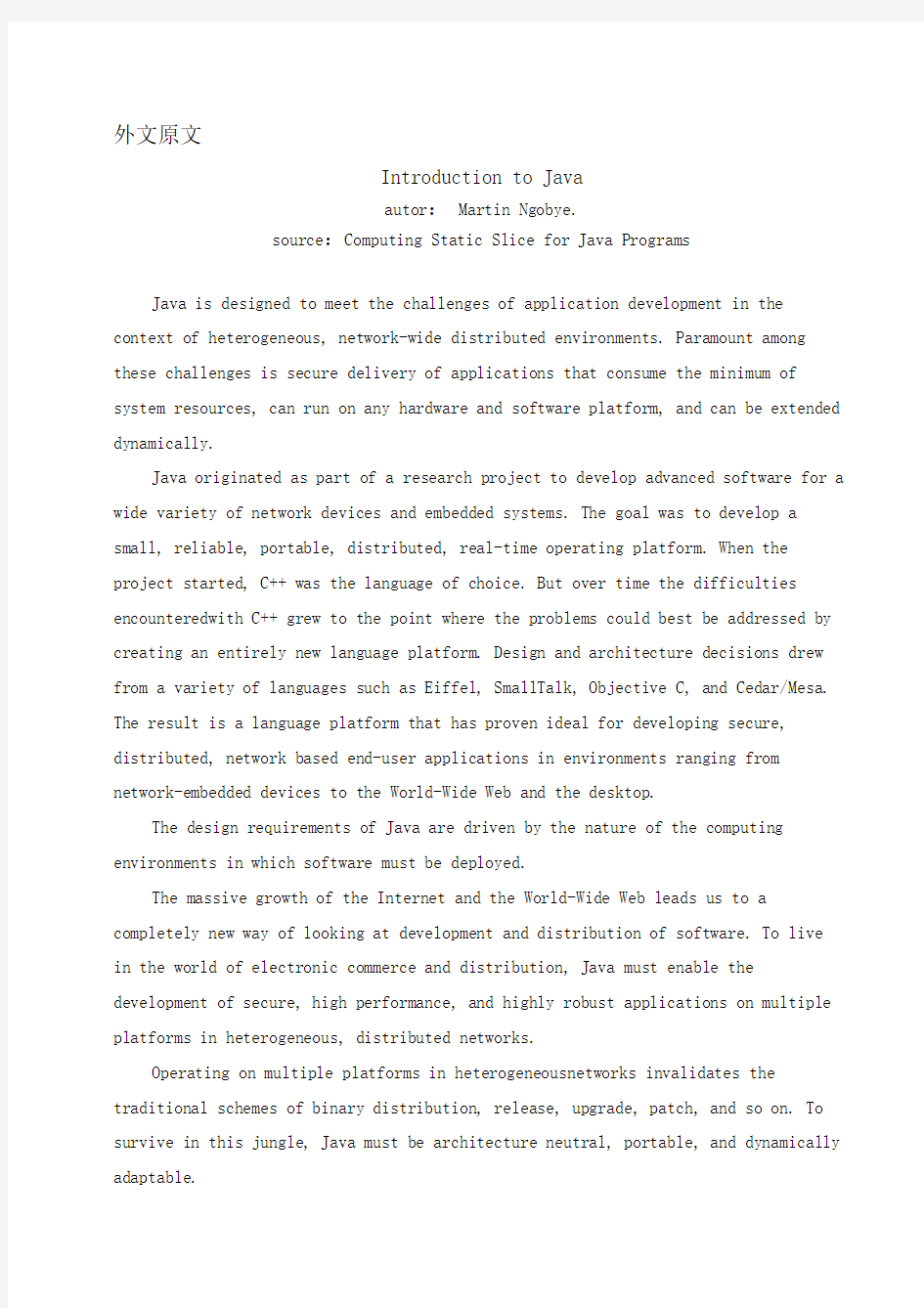java介绍外文翻译

- 1、下载文档前请自行甄别文档内容的完整性,平台不提供额外的编辑、内容补充、找答案等附加服务。
- 2、"仅部分预览"的文档,不可在线预览部分如存在完整性等问题,可反馈申请退款(可完整预览的文档不适用该条件!)。
- 3、如文档侵犯您的权益,请联系客服反馈,我们会尽快为您处理(人工客服工作时间:9:00-18:30)。
外文原文
Introduction to Java
autor:Martin Ngobye.
source:Computing Static Slice for Java Programs
Java is designed to meet the challenges of application development in the context of heterogeneous, network-wide distributed environments. Paramount among these challenges is secure delivery of applications that consume the minimum of system resources, can run on any hardware and software platform, and can be extended dynamically.
Java originated as part of a research project to develop advanced software for a wide variety of network devices and embedded systems. The goal was to develop a small, reliable, portable, distributed, real-time operating platform. When the project started, C++ was the language of choice. But over time the difficulties encounteredwith C++ grew to the point where the problems could best be addressed by creating an entirely new language platform. Design and architecture decisions drew from a variety of languages such as Eiffel, SmallTalk, Objective C, and Cedar/Mesa. The result is a language platform that has proven ideal for developing secure, distributed, network based end-user applications in environments ranging from network-embedded devices to the World-Wide Web and the desktop.
The design requirements of Java are driven by the nature of the computing environments in which software must be deployed.
The massive growth of the Internet and the World-Wide Web leads us to a completely new way of looking at development and distribution of software. To live
in the world of electronic commerce and distribution, Java must enable the development of secure, high performance, and highly robust applications on multiple platforms in heterogeneous, distributed networks.
Operating on multiple platforms in heterogeneousnetworks invalidates the traditional schemes of binary distribution, release, upgrade, patch, and so on. To survive in this jungle, Java must be architecture neutral, portable, and dynamically adaptable.
The Java system that emerged to meet these needs is simple, so it can be easily programmed by most developers; familiar, so that current developers can easily learn Java; object oriented, to take advantage of modern software development methodologies and to fit into distributed client-server applications; multithreaded, for high performance in applications that need to perform multiple concurrent activities, such as multimedia; and interpreted, for maximum portability and dynamic capabilities.
Together, the above requirements comprise quite a collection of buzzwords, so
let ' s examine some of them and their respective benefits before going on.
What' scompletely new is the manner in which Java and its run-time system have combined them to produce a flexible and powerful programming system..
Developing your applications using Java results in software that is portable across multiple machine architectures, operating systems, and graphical user interfaces, secure, and high performance, With Java, your job as a software developer is much easier—you focus your full attention on the end goal of shipping innovative products on time, based on the solid foundation of Java. The better way
to develop software is here, now, brought to you by the Java language platform.
Very dynamic languages like Lisp, TCL, and SmallTalk are often used for prototyping. One of the reasons for their success at this is that they are very robust —you don 'htave to worry about freeing or corrupting memory.
Similarly, programmers can be relatively fearless about dealing with memory when programming in Java, The garbage collection system makes the programmer 'jsob vastly easier; with the burden of memory management taken off the programmer 's houlders, storage allocation errors go away. Another reason commonly given that languages like Lisp, TCL, and SmallTalk are good for prototyping is that they don'rtequire you to pin down decisions early on—these languages are semantically rich.
Java has exactly the opposite property: it forces you to make explicit choices. Along with these choices come a lot of assistance—you can write method invocations and, if you get something wrong, you get told about it at compile time. You don'
